| Domestic pigeon | |
|---|---|

| |
| A selection of domestic pigeon breeds and colors, the result of centuries of selective breeding | |
| Conservation status | |
| Domesticated | |
| Scientific classification | |
| Domain: | Eukaryota |
| Kingdom: | Animalia |
| Phylum: | Chordata |
| Class: | Aves |
| Order: | Columbiformes |
| Family: | Columbidae |
| Genus: | Columba |
| Species: | C. livia |
| Subspecies: | C. l. domestica |
| Trinomial name | |
| Columba livia domestica Gmelin, 1789 | |
| Synonyms | |
| |
The domestic pigeon (Columba livia domestica or Columba livia forma domestica) is a pigeon subspecies that was derived from the rock dove or rock pigeon. The rock pigeon is the world's oldest domesticated bird. Mesopotamian cuneiform tablets mention the domestication of pigeons more than 5,000 years ago, as do Egyptian hieroglyphics. Pigeons were most likely domesticated in the Mediterranean at least 2000–5000 years ago, and may have been domesticated earlier as a food source. Some research suggests that domestication occurred as early as 10,000 years ago.
Pigeons have held historical importance to humans as food, pets, holy animals, and messengers. Due to their homing ability, pigeons have been used to deliver messages, including during the world wars. Despite this, city pigeons, which are feral birds, are generally seen as pests, mainly due to their droppings. Feral pigeons are considered invasive in many parts of the world, though they have a positive impact on wild bird populations, serving as an important prey species for birds of prey.
History of domestication

 Flocks of pigeons
Flocks of pigeons
Despite the long history of pigeons, little is known about the specifics of their initial domestication. Which subspecies of C. livia was the progenitor of domestics, exactly when, how many times, where and how they were domesticated, and how they spread, remains unknown. Their fragile bones and similarity to wild birds make the fossil record a poor tool for their study. Thus most of what is known comes from written accounts, which almost certainly do not cover the first stages of domestication.

The earliest recorded mention of pigeons comes from Mesopotamia some 5,000 years ago. Pigeon Valley in Cappadocia has rock formations that were carved into ancient dovecotes. Ancient Egyptians kept vast quantities of them, and would sacrifice tens of thousands at a time for ritual purposes. Akbar the Great traveled with a coterie of thousands of pigeons.
The domestic pigeon was brought to the Americas by European colonists as an easy source of food and as messengers. Around the 18th century, European interest in fancy pigeons began, and breeders there greatly expanded the variety of pigeons, importing birds from the Middle East and South Asia and mixing different breeds to create new ones.
Because domestic and feral pigeons have extensively interbred with wild rock doves, genetically pure wild-type pigeons may not exist anymore, or are nearly extinct. This frequent admixture further muddies the true origins of pigeons.
Genetics
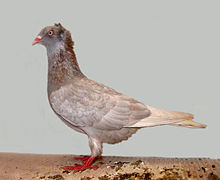
From a genetic perspective, there are two loose ancestral clades of pigeons, but there is striking genetic homogeneity due to frequent interbreeding and human directed cross-breeding; pigeon fanciers often do not enforce breed standards, unlike with dogs. The first ancestral clade contains pigeons with exaggerated crops, tails, and manes; the second contains tumblers (the most diverse group), homing pigeons, owl pigeons, and those with exaggerated wattles. Over the millennia of human interaction with pigeons, a multitude of pigeon breeds have been created, which differ in either plumage or body structure.
Markings
A wild-type pigeon is closest in markings to the rock dove, which possesses a gradienting, slate-grey head and body with a green-purple iridescent neck, and ash-grey wings and tail with dark, often black, barring. Due to millennia of selective breeding, including crossing with other Columba species, domestic pigeons possess major variations in plumage; often two birds from the same clutch may be of different color. The domestic pigeon possesses 3 main colors; the wild-type blue, brown, and ash-red. This variation in color is linked to the parent's sex chromosomes; as animals with the ZW chromosome system, cockbirds possess the color genes from both parents, while hens only inherit their father's color and patterns. Additionally, there is some dominance observed; ash-red is dominant over the other two base colors, while blue is dominant over brown. Recessive red is a unique color which is inherited differently from the three base ones; it is distinct from ash-red in that the bird always is a uniform chestnut color.
Another important aspect of pigeon markings is the pattern on the wing coverts, which exists in four variants; wild-type bar, check, T-check, and barless. T-check is the most dominant pattern, followed by check, barred, and the least dominant barless pattern. Additionally, the modifiers spread and dilute affects the expression of the color; the spread gene spreads the color of the bird's tail to its entire body, while dilute lightens the bird's overall color, as if were a dye being diluted to reduce its saturation.
Crest
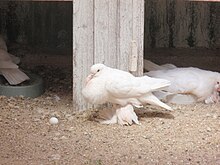
A recessive allele in the EphB2 gene controls the crested-feather mutation in domestic pigeons. Pigeons with two copies of the crest allele grow neck and head feathers that point towards the top of the head, unlike other feathers that point towards the tail. Additionally, bacterial growth analysis suggests that crested pigeons have reduced bacterial-killing abilities due to reduced kinase activity. Pigeons may express the crest gene differently depending on its genetic heritage; two squabs from the same brood descending from the same pair may have one bird develop a peak crest, and the other a wild-type smooth head.
Foot feathering
Pigeons with feathers growing on their hind feet have differently expressed genes: a hindlimb-development gene called PITX1 is less active than normal, and a forelimb-development gene called Tbx5 that normally develops the wings is also active in the feet, causing both feather growth and larger leg bones. The cause of these changes is a change in the regulatory sequences of DNA that control the expression of the Pitx1 and the Tbx5 genes, rather than mutations in the genes themselves. Pigeon foot feathering has been speculated to use similar pathways as extinct microraptorian dinosaurs, although in pigeons the foot feathering does not form an airfoil.
Hybridization
There is strong evidence that some divergences in appearance between the wild-type rock dove and domestic pigeons, such as checkered wing patterns and red/brown coloration, may be due to introgression by cross-breeding with the speckled pigeon.
Domestic pigeons may be crossed with the ringneck dove (Streptopelia risoria) to create offspring, but the offspring are not fertile.
Life history
Reproduction

Domestic pigeons reproduce exactly as wild rock pigeons do; settling in a safe, cool nook, building a flimsy stick nest, and laying two eggs that are incubated for a little longer than two weeks. A pigeon keeper may select breeding partners, but in an open loft the birds choose their own mate. Both sexes of pigeons are extremely protective of their eggs and young, and often defend them vigorously from nest predators, including their human keepers.
Baby pigeons are squabs, squeakers, or peeps, the latter two being a reference to their cry when begging for food. Initially, the squabs are fed by their parents with crop milk (or when human-raised, an appropriate substitute); some breeds are bred into such debilitating forms that they may require human intervention to produce squabs successfully, which necessitates feeding their chicks with special squab formula or by fostering them under another pair of pigeons. As they grow and become more mobile and alert, their parents transition them to their adult food of seeds and grains, and after fledging the chicks will follow their parents to the communal feeding ground; areas with plentiful forage that a pigeon flock uses. Here the chicks gain their independence and integrate into pigeon society.
Domestic pigeons were selected to breed faster than their wild ancestors; a lack of a breeding season, abundance of food in a domestic setting, and swift maturity (squabs fledge in about a month, and often have already bred and fledged a few clutches of their own before reaching a year in age) leads to swift population growth of pigeons in the flock. This fact, and the number of pigeons lost in races or intentionally released, leads to exponential growth in free-living, feral populations.
Pigeon related illness
Pigeon breeders sometimes suffer from an ailment known as bird fancier's lung or pigeon lung. A form of hypersensitivity pneumonitis, pigeon lung is caused by the inhalation of the avian proteins found in feathers and dung. It can sometimes be combated by wearing a filtered mask. Other pigeon related pathogens causing lung disease are Chlamydophila psittaci (which causes psittacosis), Histoplasma capsulatum (which causes histoplasmosis) and Cryptococcus neoformans, which causes cryptococcosis.
Uses
See also: Pigeon keepingFor food
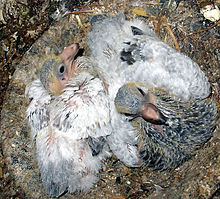
Pigeons bred for meat are generally referred to as a meat or utility breed. The term "squab" can either refer to young birds or the meat harvested from them; these birds grow to a very large size in the nest before they fledge and are able to fly; during this stage of development they are often fattier and seen as being tastier than the fully-flighted adults. Squabs during this stage are valued as food; in neolithic and early agricultural communities they were an easy and reliable source of protein, the birds requiring only reliable sources of grains and water (which they independently foraged for) to enter breeding condition, and the rock formations they nested in would have made for attractive dwellings for early humans.
Pigeon meat, both from squabs and from adult birds, are still a source of protein for people worldwide. Breeds of pigeons harvested for their meat during adulthood are collectively known as utility pigeons. For commercial meat production a breed of large white pigeon, the King pigeon, has been developed by selective breeding.
Homing pigeons
Main articles: Homing pigeon and Pigeon racing
Homing pigeons are a specialized type of pigeon bred for navigation and speed. Originally developed through selective breeding to carry messages, members of this variety of pigeon are still being used in the sport of pigeon racing and the ceremony of releasing white doves at social events.
These breeds of domestic pigeons, especially when trained are able to return to the home loft if released at a location that they have never visited before and that may be up to 1,000 km (620 mi) away. This ability of a pigeon to return home from a foreign location necessitates two sorts of information. The first, called "map sense" is their geographic location. The second, "compass sense" is the bearing they need to fly from their new location to reach their home. Both of these senses, however, respond to a number of different cues in different situations. The most popular conception of how pigeons are able to do this is that they are able to sense the Earth's magnetic field with tiny magnetic tissues in their head (magnetoception). Another theory is that pigeons have compass sense, which uses the position of the sun, along with an internal clock, to work out direction. However, studies have shown that if magnetic disruption or clock changes disrupt these senses, the pigeon can still manage to get home. The variability in the effects of manipulations to these sense of the pigeons indicates that there is more than one cue on which navigation is based and that map sense appears to rely on a comparison of available cues.
Other potential cues used include
- The use of a sun compass
- Nocturnal navigation by stars
- Visual landmark map
- Navigation by infrasound map
- Polarised light compass
- Olfactory stimuli (see also olfactory navigation)
Display
Flying/sporting
Main article: Flying/Sporting pigeons
Pigeons are also kept by enthusiasts for the enjoyment of Flying/Sporting competitions. Unlike racers, these birds are not released far from their home lofts; breeds such as tipplers are bred for the ability to hover above the loft for hours at a time. Their ability to hover for a long time shows the ability of the keeper to select for endurance.
Wild pigeons naturally somersault when evading aerial predators such as large-bodied falcons; they are naturally selected by the extreme speeds that some stooping falcons reach (over 320 km/h (200 mph)), being able to dodge this attack at the last second. Tumbler and roller pigeons are bred to enhance this ability; some birds have been recorded to be able to somersault on the ground and land on its feet, and some breeds are even deliberately bred to a point where the rolling ability is debilitative, being wholly unable to fly due to it.
Exhibition breeds
Main article: Fancy pigeonPigeon fanciers developed many exotic forms of pigeon through selective breeding. Perhaps the simplest form of display pigeon are those of white plumage, either truly albino or merely white-feathered; these white birds were seen as holy animals or heralds of peace and are well represented in both ancient and contemporary culture.
As pigeonkeepers accrued more experience, they started selecting for increasingly more unusual features in their birds; features such as unusual plumage patterns and colors, various crests, foot feathering, altered stance and proportion, or unusual behaviors are well represented in extant pigeon breeds. These birds are generally classed as fancy pigeons.
Pigeon shows are conventions where pigeon fanciers and breeders meet to compete and trade their fancy pigeons. The various pigeon breeds dubbed "American show" were developed specifically by pigeon show frequenters pursuing a certain show standard determined by the National Pigeon Association. Fanciers compete against each other at exhibitions or shows and the different forms or breeds are judged to a standard to decide who has the best bird.
There are many fancy or ornamental breeds of pigeons: among them are the English carrier pigeons, a variety of pigeon with prominent wattles and an almost vertical stance, the Duchess breed, which has as a prominent characteristic feet that are completely covered by a sort of fan of feathers, the fantails with a fan of tail feathers like a peacock, and the Voorburg Shield Cropper which are bred to inflate their crops in an attempt to seduce the human judges like they would another pigeon.
- Variety of fancy pigeons
-
 Archangel showing its extensive iridescence
Archangel showing its extensive iridescence
-
 Old Dutch Capuchine
Old Dutch Capuchine
-
 Lucerne Gold Collar
Lucerne Gold Collar
-
 Oriental Frill
Oriental Frill
-
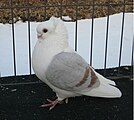 Old German Owl
Old German Owl
-
 Old Dutch Owl
Old Dutch Owl
-
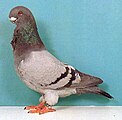 English Owl
English Owl
-
 Chinese Owl
Chinese Owl
-
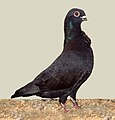 Valencian Figurita, one of the smallest breeds of pigeon
Valencian Figurita, one of the smallest breeds of pigeon
-
 Portuguese tumbler, another small breed of pigeon
Portuguese tumbler, another small breed of pigeon
-
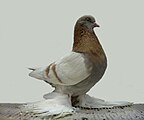 Old Dutch Tumbler
Old Dutch Tumbler
-
 The Giant Runt, one of the largest pigeon breeds
The Giant Runt, one of the largest pigeon breeds
-
 Ghent Cropper
Ghent Cropper
-
 Holle Cropper
Holle Cropper
-
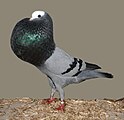 Silesian Cropper
Silesian Cropper
-
 Voorburg Shield Cropper
Voorburg Shield Cropper
-
 Norwich Cropper
Norwich Cropper
-
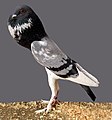 Pygmy pouter
Pygmy pouter
-
 American Show Racer
American Show Racer
-
 Dutch Beauty Homer
Dutch Beauty Homer
-
 Garden or English Fantail
Garden or English Fantail
-
 American Fantail
American Fantail
-
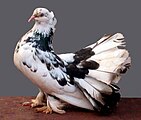 Indian Fantail
Indian Fantail
-
 Danzig Highflyer
Danzig Highflyer
-
 Oriental Roller
Oriental Roller
-
 Birmingham Roller
Birmingham Roller
-
 Danish Tumbler
Danish Tumbler
-
 Zagreb Tumbler
Zagreb Tumbler
Experimentation
Domestic pigeons are model organisms commonly used in laboratory experiments relating to biology; often to test medicines and chemical substances, or in cognitive sciences.
Pigeons have been trained to distinguish between cubist and impressionist paintings. In Project Sea Hunt, a US coast guard search and rescue project in the 1970s/1980s, pigeons were shown to be more effective than humans in spotting shipwreck victims at sea. Research in pigeons is widespread, encompassing shape and texture perception, exemplar and prototype memory, category-based and associative concepts, and many more unlisted here (see pigeon intelligence).
Pigeons are able to acquire orthographic processing skills, which form part of the ability to read, and basic numerical skills equivalent to those shown in primates.
Relation to humans
Domestic pigeons, especially the leucistic and albinistic specimens commonly referred to as "white doves", have had a long history in symbolism.
Charles Darwin was famously requested to write a book on pigeons during the process of writing his book, On the Origin of Species. He would subsequently take on pigeon fancying himself, which would ultimately lead to another book; The Variation of Animals and Plants Under Domestication.
Illegal predator killing by enthusiasts
In the United States, some pigeon keepers illegally trap and kill hawks and falcons to protect their pigeons. It is legal in some places though. In American pigeon-related organizations, some enthusiasts have openly shared their experiences of killing hawks and falcons, although this is frowned upon by some fanciers. Some of the major clubs condone this practice. It is estimated that almost 1,000 birds of prey have been killed in Oregon and Washington, and that 1,000–2,000 are killed in southern California annually. In June 2007, three Oregon men were indicted with misdemeanour violations of the Migratory Bird Treaty Act for killing birds of prey. Seven Californians and a Texan were also charged in the case.
In the West Midlands region of the United Kingdom pigeon fanciers have been blamed for a trap campaign to kill peregrine falcons. Eight illegal spring-loaded traps were found close to peregrine nests and at least one of the birds died. The steel traps are thought to have been set as part of a "concerted campaign" to kill as many of the birds as possible in the West Midlands.
Feral pigeons
Main article: Feral pigeonMany domestic birds have escaped or been released over the years, and have given rise to the feral pigeon. As a result of natural variation, feral pigeons demonstrate a wide variety of plumages, ranging from closely resembling wild rock doves, to patterns directly inherited from their domestic ancestors, though over time a population tends to homogenize and adopt a plumage that suits their environment, such as camouflaging against black asphalt. The scarcity of the pure wild species is partly due to interbreeding with feral birds. Domestic pigeons can often be distinguished from feral pigeons because they usually have a metal or plastic band around one (sometimes both) legs which shows, by a number on it, that they are registered to an owner.
Feral pigeons bear striking genetic resemblance to homing pigeons, supporting the idea that most feral pigeons trace their origins to homing pigeons who did not find their way home, or were otherwise sired by homing pigeons. The huge numbers of birds released in pigeon races and loft owners breaking down their lofts and leaving the pigeons to fend for themselves may be a significant factor in the persistence of urban pigeons.
Notes
- Breeds depicted are:
- Middle-billed Tumbler
- German Drum
- Anatolian Turbit
- Roman
- Coburg Lark
- Antwerp Carrier
- Strasser
- Lynx
- Nun
- Maltese
- Carrier
- Long-billed Tumbler
- Fantail
- English Pouter
References
- "Columba livia Gmelin, 1789" (Web data). ITIS Report. Retrieved 26 February 2008.
- Krautwald-Junghanns, Maria-Elisabeth; Zebisch, Ralph; Schmidt, Volker (2009). "Relevance and Treatment of Coccidiosis in Domestic Pigeons (Columba livia forma domestica) with Particular Emphasis on Toltrazuril". Journal of Avian Medicine and Surgery. 23 (1). Association of Avian Veterinarians: 1–5. doi:10.1647/2007-049R.1. JSTOR 27670700. PMID 19530399. S2CID 31939394.
- Stringham, Sydney A.; Mulroy, Elisabeth E.; Xing, Jinchuan; Record, David; Guernsey, Michael W.; Aldenhoven, Jaclyn T.; Osborne, Edward J.; Shapiro, Michael D. (February 2012). "Divergence, Convergence, and the Ancestry of Feral Populations in the Domestic Rock Pigeon". Current Biology. 22 (4): 302–308. Bibcode:2012CBio...22..302S. doi:10.1016/j.cub.2011.12.045. PMC 3288640. PMID 22264611.
- Blechman, Andrew (2007). Pigeons-The fascinating saga of the world's most revered and reviled bird. St Lucia, Queensland: University of Queensland Press. ISBN 978-0-7022-3641-9.
- Levi, Wendell (1977). The Pigeon. Sumter, S.C.: Levi Publishing Co, Inc. ISBN 978-0-85390-013-9.
- Capoccia, Stella; Boyle, Callie; Darnell, Tedd (2018). "Loved or loathed, feral pigeons as subjects in ecological and social research". Journal of Urban Ecology. 4 (1). doi:10.1093/jue/juy024.
- Rodríguez, Beneharo; Rodríguez, Airam; Siverio, Felipe; Martínez, Juan M.; Sacramento, Enrique; Acosta, Yarci (June 2022). "Introduced predators and nest competitors shape distribution and breeding performance of seabirds: feral pigeons as a new threat – Biological Invasions". Biological Invasions. 24 (6): 1561–1573. doi:10.1007/s10530-022-02746-1. Retrieved 3 May 2024.
- ^ Gilbert, M. Thomas P.; Shapiro, Michael D. (2014). "Pigeons: Domestication". Encyclopedia of Global Archaeology. pp. 5944–5948. doi:10.1007/978-1-4419-0465-2_2214. ISBN 978-1-4419-0426-3.
- ^ Hester, Jessica Leigh (29 November 2021). "The Case for Pigeon-Watching". atlasobscura.com. Atlas Obscura. Retrieved 30 November 2023.
- "Secret World of Pigeons Timeline". cbc.ca. CBC. Retrieved 30 November 2023.
- Parks, Shoshi (25 January 2023). "Did Ancient Egypt Have a Pigeon Problem?". atlasobscura.com. Atlas Obscura. Retrieved 30 November 2023.
- Kabir, M. Ashraful (18 October 2023). "Social and Basic Sciences Review". Researchgate.net. Retrieved 18 October 2023.
- "The Royal Pigeons". birdnote.org. BirdNote. 23 February 2022. Retrieved 30 November 2023.
- "5 Animals the Mughal Emperor Akbar loved". theheritagelab.in. The Heritage Lab. 3 July 2020. Retrieved 30 November 2023.
- "Color". learn.genetics.utah.edu. University of Utah. Retrieved 16 November 2023.
- "Recessive Red". learn.genetics.utah.edu. University of Utah. Retrieved 16 November 2023.
- "Pattern". learn.genetics.utah.edu. University of Utah. Retrieved 16 November 2023.
- "Spread". learn.genetics.utah.edu. University of Utah. Retrieved 16 November 2023.
- "Dilute". learn.genetics.utah.edu. University of Utah. Retrieved 16 November 2023.
- "The Secret of the Pigeon's Crest". www.science.org. Retrieved 28 May 2023.
- "Crest". learn.genetics.utah.edu. Retrieved 28 May 2023.
- Vickrey, Anna I.; Domyan, Eric T.; Horvath, Martin P.; Shapiro, Michael D. (October 2015). "Convergent Evolution of Head Crests in Two Domesticated Columbids Is Associated with Different Missense Mutations in EphB2". Molecular Biology and Evolution. 32 (10): 2657–2664. doi:10.1093/molbev/msv140. ISSN 1537-1719. PMC 4683366. PMID 26104009.
- "Crest". learn.genetics.utah.edu. University of Utah. Retrieved 30 November 2023.
- "Foot Feathering". learn.genetics.utah.edu. Retrieved 28 May 2023.
- "Pigeon foot feather genes identified | UNews". unews.utah.edu. Retrieved 28 May 2023.
- Ottenburghs, Jente (12 December 2014). "Columbiformes". Avian Hybrids.
- Vickrey, Anna I; Bruders, Rebecca; Kronenberg, Zev; Mackey, Emma; Bohlender, Ryan J; Maclary, Emily T; Maynez, Raquel; Osborne, Edward J; Johnson, Kevin P; Huff, Chad D; Yandell, Mark; Shapiro, Michael D (17 July 2018). "Introgression of regulatory alleles and a missense coding mutation drive plumage pattern diversity in the rock pigeon". eLife. 7. doi:10.7554/eLife.34803. PMC 6050045. PMID 30014848.
- Irwin, M. R.; Cole, L. J.; Gordon, C. D. (1936), "Immunogenetic studies of species and of species hybrids in pigeons, and the separation of species-specific characters in backcross generations", Journal of Experimental Zoology, 73 (2): 285–308, Bibcode:1936JEZ....73..285I, doi:10.1002/jez.1400730206
- Miller, Wilmer J. (1953). "The Time of Appearance of Species-Specific Antigens of Columba guinea in the Embryos of Backcross Hybrids". Journal of Physiological Zoology. 26 (2): 124–131. doi:10.1086/physzool.26.2.30154509. S2CID 87693174.
- "Known Dove/Pigeon Hybrids". www.exoticdove.com. Retrieved 28 May 2023.
- "Convergent Evolution of Head Crests in Two Domesticated Columbids Is Associated with Different Missense Mutations in EphB2". academic.oup.com. Retrieved 28 May 2023.
- Gorman, Kate. "Bird lady of Haslet helps to elevate occasions". Star Telegram (15 Jun 2008). Archived from the original on 2 April 2019. Retrieved 25 June 2008.
- ^ Bodio, Stephen J. (15 July 2009). "Darwin's Other Bird—The Domestic Pigeon". allaboutbirds.org. The Cornell Lab of Ornithology. Retrieved 16 November 2023.
- Boyd, Gavin; Din Ismail; Philip Lynch; Charles McSharry. "Process of Pigeon Fancier's Allergic Alveolitis.Current research activity into Pigeon Lung in Scotland: Epidemiological Studies". British Pigeon Fanciers Medical Research. Archived from the original (Web article) on 8 July 2008. Retrieved 22 January 2008.
- Von Middendorff, A. (1859). "Die Isepiptesen Rußlands". Mémoires de l'Académie Impériale des Sciences de St. Pétersbourg. Série VI. 8: 1–143.
- Viguier, C. (1882). "Le sens de l'orientation et ses organes chez les animaux et chez l'homme". Revne Philosophique de la France et de l'Étranger. 14: 1–36. JSTOR 41071133.
- Wiltschko, W.; Wiltschko, R. (1996). "Magnetic Orientation in Birds". Journal of Experimental Biology. 199 (Pt 1): 29–38. doi:10.1242/jeb.199.1.29. PMID 9317275.
- Wiltschko, W.; Wiltschko, R. (2003). "Avian navigation: from historical to modern concepts". Animal Behaviour. 65 (2): 257–272. doi:10.1006/anbe.2003.2054. S2CID 53184279.
- Wallraff, H.G. (1999). "The roles of the sun and the landscape in pigeon homing". Journal of Experimental Biology. 202 (16): 2121–2126. doi:10.1242/jeb.202.16.2121. PMID 10409483.
- Kramer., Gustav (3 April 2008). "Experiments in bird orientation". Ibis. 94 (2): 265–285. doi:10.1111/j.1474-919X.1952.tb01817.x.
- Baker, R.R. (1984). Bird Navigation: The Solution of a Mystery? London: Hodder & Stoughton.
- Kamil, A.C.; Cheng, K. (2001). "Way-finding and landmarks: the multiple-bearing hypothesis". Journal of Experimental Biology. 204 (Pt 1): 103–113. doi:10.1242/jeb.204.1.103. PMID 11104714.
- Hagstrum, Jonathan T. (September 2001). "Infrasound and the Avian Navigational Map". Journal of Navigation. 54 (3): 377–391. Bibcode:2001JNav...54..377H. doi:10.1017/S037346330100145X. S2CID 17357175. ProQuest 229557494.
- Able, K.P.; Able, M.A. (1993). "Daytime calibration of magnetic orientation in a migratory bird requires a view of skylight polarization". Nature. 364 (6437): 523–525. Bibcode:1993Natur.364..523A. doi:10.1038/364523a0. S2CID 4330244.
- Papi, Floriano (1 January 1986). "Pigeon Navigation: Solved Problems and Open Questions". Monitore Zoologico Italiano. 20 (4): 471–517. doi:10.1080/00269786.1986.10736514 (inactive 1 November 2024). INIST 8067206.
{{cite journal}}: CS1 maint: DOI inactive as of November 2024 (link) - Watanabe, S.; Sakamoto, J.; Wakita, M. (March 1995). "Pigeons' discrimination of paintings by Monet and Picasso". Journal of the Experimental Analysis of Behavior. 63 (2): 165–174. doi:10.1901/jeab.1995.63-165. PMC 1334394. PMID 16812755.
- "Pigeon Search and Rescue Project (Project Sea Hunt)". United States Coast Guard. 28 May 2009. Retrieved 12 January 2010.
- Damian Scarf; Karoline Boy; Anelisie Uber Reinert; Jack Devine; Onur Güntürkün; Michael Colombo (2016). "Orthographic processing in pigeons (Columba livia)". Proceedings of the National Academy of Sciences. 113 (40): 11272–11276. Bibcode:2016PNAS..11311272S. doi:10.1073/pnas.1607870113. PMC 5056114. PMID 27638211.
- Damian Scarf; Harlene Hayne; Michael Colombo (2016). "Pigeons on par with primates in numerical competence". Science. 334 (6063): 1664. doi:10.1126/science.1213357. PMID 22194568. S2CID 33936018.
- Milstein, Michael (9 June 2007). "Fight pits pigeon, hawk lovers". The Oregonian. Archived from the original on 2 January 2008. Retrieved 11 June 2007.
- Smith, Lewis (30 May 2008). "Pigeon fanciers blamed for trap campaign to kill peregrine falcons" (Online news). London: Times Online. Retrieved 20 June 2008.
- Porter, Cynthya. "Goodview man finds racing pigeon". Winona Post. Archived from the original on 18 July 2011. Retrieved 15 July 2008.
External links
- National Pigeon Association (USA)
- National Pigeon Association (Great Britain) Archived 28 July 2013 at the Wayback Machine
- The Canadian Pigeon Fanciers Association
- Domestic Pigeons Explained (Pigeonpedia)
- Pigeonetics, a game by the University of Utah
| Pigeons and doves (Columbidae) | |
|---|---|
| Life and behavior | |
| Breeds and types | |
| Relationship with humans | |
| Organizations | |
| Related | |
| Taxon identifiers | |
|---|---|
| Columba livia f. domestica | |